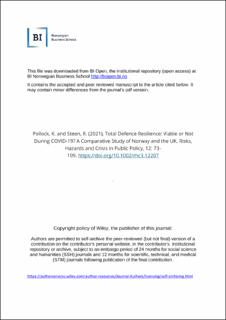| dc.contributor.author | Pollock, Kevin | |
| dc.contributor.author | Steen, Riana | |
| dc.date.accessioned | 2022-01-04T14:15:16Z | |
| dc.date.available | 2022-01-04T14:15:16Z | |
| dc.date.created | 2020-11-05T11:08:38Z | |
| dc.date.issued | 2020 | |
| dc.identifier.citation | Risk, Hazards & Crisis in Public Policy, 2021, 12 (1),73-109. | en_US |
| dc.identifier.issn | 1944-4079 | |
| dc.identifier.uri | https://hdl.handle.net/11250/2836022 | |
| dc.description.abstract | The Total Defence (TD) concept aims to provide an effective crisis response structure by increasing societal resilience. However, the complexity of its structure regarding resource mobilisation and management process highlights the need for a complexity-oriented approach in the operationalising of TD. We study the application of TD during the COVID19 crisis and explore what makes the TD a viable system with resilience capabilities in the face the crisis. We apply the Viable Systems Model as a methodology to compare the viability of the UK and Norwegian TD systems, both of which use systems networks to achieve resilience, and contrast the different outcomes of each country. Our analysis highlights that: Managing the complexity of the TDS requires that all of the involved agencies proactively adopt a transparent approach to a joint decision making. This demands a wide range of sources of innovative solutions at different levels. Joint exercises, developed by the responsible agencies, enhance mutual understating of roles and responsibilities and crisis response structure. This calls for institutionalised support to dedicate resources. To avoid communications challenges, involved agencies in the TDS need to adopt an open messaging strategy, highlighting how to deal with uncertainties in communicating of decisions and action. | en_US |
| dc.language.iso | eng | en_US |
| dc.publisher | Wiley | en_US |
| dc.title | Total Defence Resilience: viable or not during COVID-19? A comparative study of Norway and the UK. | en_US |
| dc.type | Journal article | en_US |
| dc.type | Peer reviewed | en_US |
| dc.description.version | acceptedVersion | en_US |
| dc.source.pagenumber | 73-109 | en_US |
| dc.source.volume | 12 | en_US |
| dc.source.journal | Risk, Hazards & Crisis in Public Policy | en_US |
| dc.source.issue | 1 | en_US |
| dc.identifier.doi | 10.1002/rhc3.12207 | |
| dc.identifier.cristin | 1845192 | |
| cristin.ispublished | true | |
| cristin.fulltext | postprint | |
| cristin.qualitycode | 1 | |
